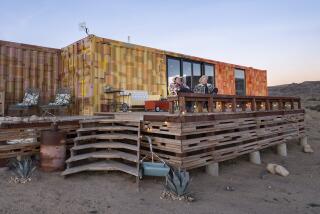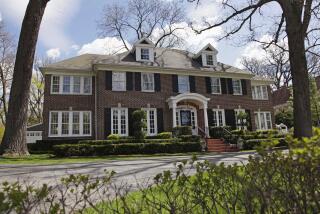Interior Motives and Exterior Eccentricities
Chris Smith became interested in the subject matter of his latest project, “Home Movie,” about 10 years ago. “I went to visit an artist in Georgia named Howard Finster,” Smith recalls. “He had a thing called Paradise Garden, and we went to visit his house and were completely taken with the world that he had created.”
To his wish list of “must-do” films, Smith added “a film about people that have created universes that they [also] live in.” He admits, though, that it was one of those quirky ideas he “probably would have never gotten around to” had he not been contacted by like-minded producers John Shirley, Richard Siegel and Stuart Wolff.
“They had come up with this idea to film people with different homes,” Smith recalls. “I told them how odd it was, because I was completely fascinated with this world. I think that’s a large part of why they picked me to direct this film.”
“Home Movie,” which opens today in selected theaters, is Smith’s guided tour into the nooks, crannies and, most important, the personalities of five spectacular American homes and the flamboyant proprietors for which each abode is both an extension and a fundamental mode of expression. Shot on location in five sharply contrasting settings, the homes include the “all electronic” suburban Chicago home of inventor Ben Skora, whose rooms change places and shape and whose toilet and easy chair are jet propelled; the treehouse of the elderly former Japanese movie idol Linda Beech, set amid the dreamy, mist-enshrouded arbors of a Hawaiian rain forest; the lavish underground bunker of a New Age couple, the Pedens, whose formidable digs are the reclaimed interior of a hollowed-out missile silo.
The five homes and personalities showcased in “Home Movie” were selected from nearly 1,000 possibilities. “We had a lot of information coming in and leads on different homes,” Smith says. “We would look through them and find things that we liked. There was a videotape generated of about 100 of the homes, and from that we were able to gauge the people. It was a fairly labor-intensive process.”
They selected homes in Louisiana, Illinois, California, Hawaii and Kansas. “That wasn’t on purpose,” Smith explains. “We were looking for anything that worked, and for me it was really important to find people whose lives were completely integrated with their homes--and that the two seemed inseparable. If they were all in Arizona, that would have been fine for me. Ultimately it came down to finding people who were as interesting as their homes.”
Smith took a mere 10 days to shoot the film once he and his producers settled on the five finalists. “It was intense,” Smith recalls. “Excluding travel, literally, I shot from the minute I showed up to the minute I left. I shot two days in each home. We had them wearing the same clothes two days in a row. The first conversation I had about the film was in March of 2000, and we showed it at the Sundance Film Festival in January 2001.”
Smith began his career writing features. “I did a film called ‘American Job’ that was at Sundance in 1996. Right after that I wrote a second script that went to the Sundance writing lab in 1997. So for me, I was headed on the track of trying to make narrative films. It was purely by chance that I ran into Mark Borchardt, the main character in ‘American Movie,’” his follow-up to “American Job.” “What started out as a small side project turned into a four-year endeavor.”
More to Read
Only good movies
Get the Indie Focus newsletter, Mark Olsen's weekly guide to the world of cinema.
You may occasionally receive promotional content from the Los Angeles Times.










